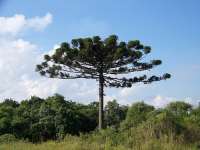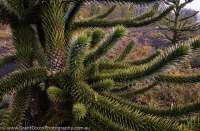Here/There Matthew Slaats
Project Proposal
Here/There is a virtual 3D exploration of the spatial, temporal, economic and physical relationships between environments in North and South America.
Project Description
Here/There aims to illustrate our sense of the tight connection between the local and global, real space and virtual space, our environment and our culture. By symbolically reversing the destruction of the araucaria tree in Chile, the project brings local, situated knowledge of the environment into the virtual and conceptual realm by which global ecology is known. A collaboration between artist Matthew Slaats and environmental researcher Niall Stephens, the project is a unique opportunity to stimulate action for the environment, and to foster an awareness of the importance of the environment for art and for life.
Here/There begins with the people of the Araucanía region in Chile, which forms the focus of Mr. Stephens 2010-11 Fulbright Fellowship. During his research he will walk and talk with people, exploring their connection with the land they live on. The narratives they offer will provide an understanding of how they see and use their environment, their individual and collective histories, and connections to the space around them. Of particularly interest are stories of araucaria trees. The araucaria, from which this region derived its name, is the national tree of Chile. A unique and distinctive conifer, it has been described as a living fossil, both for its prehistoric appearance and for the fact that it lives for a millennium. Its slow growth cycle has led timber companies, whose activities in this region have exploded in the last three decades, to plant non-native eucalyptus and fir species in its place. This has transformed the ecology of the region, drastically reducing the araucaria population and causing serious environmental damage, from species extinction to contamination and depletion of the water table. Our encounters with the people affected by this destruction will be collected in an archive of audio and video content, a living document of the meaning bound up with these trees and this place, and a resource for scholars and artists to draw from in the future.
The archive will then be linked to a virtual space, and become part of “third nature” – nature as experienced through telesthesia and media. The third nature concept comes from the Australian cultural theorist McKenzie Wark, and points to the new ways nature is understood and experienced in the information age. If first nature is the natural non-human world, and second nature is the natural world as lived in and shaped by humans, third nature is nature as conceptualized through information and communication technology. It is the computerized climate models of scientists, astronauts’ photographs of Earth, the animated weather maps of television meteorologists, and Google Earth. In a globalized economy in which timber from Chile becomes furniture in American and European homes, third nature makes possible our awareness of a unified global ecology.
Mr. Slaats will intervene in third nature by symbolically reversing the araucaria’s decline, planting virtual araucarias onto virtual spaces. Urban centers in the countries that import Chilean lumber will become new growth forest, as large-scale transplantation of eucalyptus and fir into the araucaria’s habitat is balanced by a massive transplantation of araucarias in North America, Europe and Asia. Each tree will serve as a hyperlink to an element in our archive. Selecting one, users will be directed to the media and narratives collected in Chile to experience what the tree means to the people of Araucanía.
A physical monument, an araucaria made from materials emblematic of the species’ destruction, will complement this transplantation of seven thousand virtual araucaria trees. The tree’s trunk and branches will be made of timber from the eucalyptus and fir plantations that are destroying its habitat, and its foliage will be fashioned using plastic bottles and aluminum cans. The objective, again, is to symbolically reverse the destruction of the araucaria, here with a concrete artifact that can have a lasting presence in Chile and the United States. This piece will be displayed in both countries, fostering a discussion about global trade and the environment.
During his time as a Fellow, Mr. Slaats will focus his attention on the development of a web interface, online archive and the designing of the physical araucaria trees. In his pursuit of these objectives, we will wishes to engage students and faculty in the design and conceptual processes of the project. Specific relationships would be built with the Parsons School for Art and Design and the New School for Social Research.
Here/There Matthew Slaats
Project Proposal
Here/There is a virtual 3D exploration of the spatial, temporal, economic and physical relationships between environments in North and South America.
Project Description
Here/There aims to illustrate our sense of the tight connection between the local and global, real space and virtual space, our environment and our culture. By symbolically reversing the destruction of the araucaria tree in Chile, the project brings local, situated knowledge of the environment into the virtual and conceptual realm by which global ecology is known. A collaboration between artist Matthew Slaats and environmental researcher Niall Stephens, the project is a unique opportunity to stimulate action for the environment, and to foster an awareness of the importance of the environment for art and for life.
Here/There begins with the people of the Araucanía region in Chile, which forms the focus of Mr. Stephens 2010-11 Fulbright Fellowship. During his research he will walk and talk with people, exploring their connection with the land they live on. The narratives they offer will provide an understanding of how they see and use their environment, their individual and collective histories, and connections to the space around them. Of particularly interest are stories of araucaria trees. The araucaria, from which this region derived its name, is the national tree of Chile. A unique and distinctive conifer, it has been described as a living fossil, both for its prehistoric appearance and for the fact that it lives for a millennium. Its slow growth cycle has led timber companies, whose activities in this region have exploded in the last three decades, to plant non-native eucalyptus and fir species in its place. This has transformed the ecology of the region, drastically reducing the araucaria population and causing serious environmental damage, from species extinction to contamination and depletion of the water table. Our encounters with the people affected by this destruction will be collected in an archive of audio and video content, a living document of the meaning bound up with these trees and this place, and a resource for scholars and artists to draw from in the future.
The archive will then be linked to a virtual space, and become part of “third nature” – nature as experienced through telesthesia and media. The third nature concept comes from the Australian cultural theorist McKenzie Wark, and points to the new ways nature is understood and experienced in the information age. If first nature is the natural non-human world, and second nature is the natural world as lived in and shaped by humans, third nature is nature as conceptualized through information and communication technology. It is the computerized climate models of scientists, astronauts’ photographs of Earth, the animated weather maps of television meteorologists, and Google Earth. In a globalized economy in which timber from Chile becomes furniture in American and European homes, third nature makes possible our awareness of a unified global ecology.
Mr. Slaats will intervene in third nature by symbolically reversing the araucaria’s decline, planting virtual araucarias onto virtual spaces. Urban centers in the countries that import Chilean lumber will become new growth forest, as large-scale transplantation of eucalyptus and fir into the araucaria’s habitat is balanced by a massive transplantation of araucarias in North America, Europe and Asia. Each tree will serve as a hyperlink to an element in our archive. Selecting one, users will be directed to the media and narratives collected in Chile to experience what the tree means to the people of Araucanía.
A physical monument, an araucaria made from materials emblematic of the species’ destruction, will complement this transplantation of seven thousand virtual araucaria trees. The tree’s trunk and branches will be made of timber from the eucalyptus and fir plantations that are destroying its habitat, and its foliage will be fashioned using plastic bottles and aluminum cans. The objective, again, is to symbolically reverse the destruction of the araucaria, here with a concrete artifact that can have a lasting presence in Chile and the United States. This piece will be displayed in both countries, fostering a discussion about global trade and the environment.
During his time as a Fellow, Mr. Slaats will focus his attention on the development of a web interface, online archive and the designing of the physical araucaria trees. In his pursuit of these objectives, we will wishes to engage students and faculty in the design and conceptual processes of the project. Specific relationships would be built with the Parsons School for Art and Design and the New School for Social Research.

